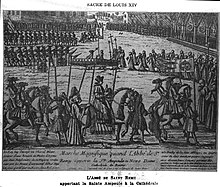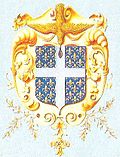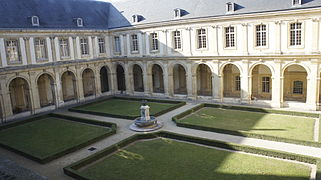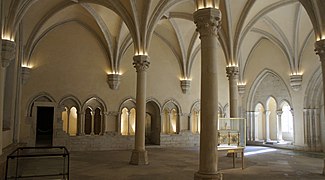Draft:Abbey of Saint-Remi
This article may be a rough translation from French. It may have been generated, in whole or in part, by a computer or by a translator without dual proficiency. (July 2024) |
The Abbey of Saint-Remi in Reims is a former Benedictine abbey in Reims, now the Musée Saint-Remi. Around 760, Tilpin, Archbishop of Reims, founded the Abbey of Saint-Remi and established a Benedictine religious community there that remained until the French Revolution. The abbey experienced significant economic and spiritual growth during the Middle Ages and a remarkable revival in the 12th and 13th centuries. For the Coronation of the French monarch, which took place in the Reims Cathedral, the ampulla containing the chrism, or holy oil, was brought from the Abbey of Saint-Remi. The Abbey of Saint-Remi exerted control over the parishes within its ban and over two collegiate churches, including that of Saint-Timothy.
History
[edit]A first monastery may have been founded by Saint Remi, bishop of Reims, where he was buried in 533. Around 750-770 (or in 790, according to some sources), Bishop Tilpin founded a Benedictine abbey on the tomb of Saint Remi, which had become a pilgrimage site[1].
Around 852, Hincmar requested the reconstruction of the building housing the relics of Saint Remi and the Holy Ampulla.
In 1010, Abbot Airard (1007-1035), one of the first abbots elected by the monks, began the reconstruction of the abbey. A large Romanesque church was built, which was modified during the abbacy of Thierry (1036-1048). The abbey church, named a basilica, was consecrated by Saint Leo IX on 2 October 1049.
Hérimar (1048-1076) received lands in Viré from Manasses de Châtillon (sur-Marne), known as "The Bald," vidame of Reims, to build a farm in exchange for a rent of 100 sols. This act was confirmed in 1053 by the donor’s uncle Guy of Châtillon, Archbishop of Reims, in the presence of Roger, Count of Porcien; Manasses, Count of Rethel; Renaud, Count of Soissons; Guy I of Châtillon, Lord of Châtillon, nephew of the archbishop, and cousin of the donor; Geoffroi, Miles, and Aleman, knights of Châtillon, witnesses to an agreement between Manasses, Count of Porcien, and his nephew with Gervais of Belleme, Archbishop of Reims, in 1055.
Monastic life, which flourished in the 12th century, declined with the Hundred Years' War. Under Louis XI, the abbey came under commendation and was led by a Grand Prior. Most commendatory abbots neglected the abbey.

The abbey church and cloisters of Saint-Remi were almost entirely destroyed by a terrible fire that broke out in the abbey on the night of January 15 to 16, 1774. Many invaluable treasures from the library (900 manuscripts), which contained 20,000 volumes, perished in this catastrophe, including the famous manuscript of the fables of Phaedrus from the 8th century[2][3], the cartulary known as the Polyptych[Note 1] of Saint-Remi[4], reportedly started by Bishop of Reims, Leudégisile, around 634; the collection of chapter acts and two unpublished histories of the abbey by the Benedictines Dom Égée and Dom Levacher.

Fortunately, the book of Origins by Saint Isidore, written around 750; the pontifical of Archbishop Hincmar, from 780; a sacramentary of Saint Gregory, dating from 799; and the Hours of Queen Emma, wife of Louis IV of France. Rebuilt after the fire, the abbey buildings were entirely modern[5]. Architect Louis Duroché restored the courtyard, staircase, and current facade.
On February 13, 1790, the Constituent Assembly declared the abolition of monastic vows and the suppression of religious congregations. The monks were expelled in 1793. The abbey then served as a military barracks.
Hospital Function
[edit]A hospice had long been an integral part of the abbey, as seen in the buildings at the bottom right of the image above. The entire abbey was converted into a military hospital in 1796, until 1816, then into a Hôtel-Dieu from June 1827. It became a civil hospital from 1905 until the Interwar period.
The abbey cloister was classified as a historical monument by the list of 1889; with the decrees of April 15, 1920, and December 1, 1933, various other elements of the abbey were also classified[6].
Conversion into a Museum
[edit]Today, the abbey premises house the Museum of History and Archaeology of Reims. The abbey church has become a parish church, still a basilica.
The former royal Benedictine abbey was classified as a World Heritage Site by UNESCO in 1991[7].
The Abbey Church
[edit]Two collegiate churches (Saint-Timothy and Saint-Côme-et-Saint-Damien) and a parish church (Saint-Julien) were associated with Saint-Remi. The almonry with a chapel dedicated to Saint-Laurent was located south of the abbey church, while the monastic buildings were to the north. The abbot's residence was situated to the north of the main cloister. The infirmary, with a chapel dedicated to Saint-Christophe, occupied the small cloister, located east of the chapter house[8]
Abbots
[edit]
Regular Abbots
[edit]The founder, Tilpin, reserved the title of abbot for himself. Subsequently, the Archbishops of Reims became the abbots of Saint-Remi. Hugues de Vermandois was the last archbishop be the abbot of Saint-Remi[1]. In 945, an independent abbot was appointed.
Commendatory Abbots
[edit]In 1482, the series of commendatory abbots began with Robert de Lenoncourt:
Priors, Monks, and Notable Figures
[edit]- Gossuin d'Anchin (ca 1085-1165), called upon to rebuild the abbey.
- Athanase de Mongin (1589-1633).
- Jean Mabillon (1632-1707), French historian.
- Jean-Baptiste Alaydon (1671-1691).
- Pierre Chastelain (1709-1782), author of a work on vineyards.
Priories
[edit]The abbey's influence extended to the priories where it sent its monks and collected revenues: Rethel, Chagny, Senuc, Condes, founded in 961 by Abbot Hugues[9], Le Chesne, Marcoul, Haschbach, and the provostries of Echarson, Braux-Saint-Remy, Dhuizel, Courtisols, ceded to the seminary of Châlons in 1702, Louvemont[10], Grandpré, Saint-Thomas[11].
The provostry of Meerssen depended on Saint-Remi Abbey, which later exchanged it for two priories dependent on the Abbey of Our Lady of Eaucourt[12].
Contributions
[edit]The Abbey's Land Holdings
[edit]Carloman, brother of Charlemagne, who was buried in the abbey church of Saint-Remi, gave the land of Neuilly (Novion or Neuvizy).
In 968, Queen Gerberga of Saxony, daughter of King Henry I, wife of Louis IV, donated all her property from the allod of Meerssen.
The motte of Coucy was built by order of the Archbishop of Reims, Hervé. Coucy likely remained a fief of the Archbishops of Reims or Saint-Remi Abbey until the end of the 10th century.
Jean-Pierre Devroey indicates that the property of the Church of Reims and that of Saint-Remi were nearly indistinguishable until the early 9th century. It seems certain that between the episcopate of Saint Rieul (670-696) and the year 945, when an independent abbot was appointed, the temporal assets of the cathedral domain and those of Saint-Remi formed a single entity. The drafting of a polyptych was the first effort to distinguish the domains of one from the other[13].
- List of cens in the Polyptych of Saint-Remi:
It lists 24 fiscs around the middle of the 9th century, each consisting of a seigneurial manse (Mansus Domminicatus) and tributary manses, in the regions of Reims (Pagus Remensis), Laon (Pagus ?), Tardenois (Pagus Tardinensis), and Porcien (Pagus Porcensis)[14].
- I. Adenaus: Anthenay?
- II. Mutalio, Mutationes: Muizon
- III. Floreius: Fleury-la-Rivière
- IV. Alhiliacus: Aubilly
- V. Baconna: Baconnes
- VI. Vicus Sancti Remigii: the Saint-Remi borough, in Reims
- VII. Lurba: Lalobbe
- VIII. Trielonpus: Treslon
- IX. Gothi: Gueux
- X. Decima de abbatia Sancti Timothei, ad hospititum Sancti Remigii: Tithe of the Abbey of Saint-Timothy of Reims, at the hospice of Saint-Remi.
- Insula super Suppia: Isles-sur-Suippe
- Loca ad portam monasterii Sancti Remigii deputata: at the gate of the monastery of Saint-Remi.
- XI. Nantoilus: Nanteuil-la-Fosse
- XII. Tasiacus: Taissy or Taizy
- XIII. Notitia census debiti villarum Sancti Remigii: Abbey of Saint-Remi
- XIV. Luperciacus: Louvercy
- XV. Villaris:
- XVI. Insula Catzeia: Chézy-l'Abbaye
- XVI. Insula Catzeia: [Chézy-l'Abbaye]
- XVII. Curtis Agutior: [Aguilcourt]
- XVIII. Baina: [Beine]
- XIX. Beconis Villa: [Baconnes]
- XX. Vicus: with a church dedicated to Saint Remi.
- XXI. Gerso: [Gerson]
- XXII. Salix sancti Remigii: [Sault-Saint-Remy]
- XXIII. Villina:
- XXIV. Sanctus Ililarius: [Saint-Hilaire-le-Grand]
In 961, Hugues IV de Bassigny, Count of Bassigny and Bolenois, donated the curtis of Condes to be buried at Saint-Remi and bequeathed the Val-de-Rognon to the canons.
The founding charter of the Collegiate Church of Saint-Timothée de Reims on June 13, 1064, stipulated that the abbot of Saint-Remi had the right to confer prebends in the collegiate church.
On December 14, 1145, a papal bull from Pope Eugene III specified the possessions of the Abbey of Saint-Remi and mentioned Alendusium (Alland'Huy), already appearing in the Polyptych of Saint-Remi.
Vrizy is mentioned for the first time in 1154 in a papal act under Adrian IV, as one of the properties of the Abbey of Saint-Remi.
In 1207, a charter of franchise for the inhabitants of Le Chesne was signed between Hugues II, Count of Rethel, and Guy, abbot of Saint-Remi.
In 1234, an agreement was signed between the Abbey of Saint-Remi and the community of Amagne, by which the abbey was relieved of the responsibility for the church's roof.
Since the Middle Ages, the abbey has held a lordship in Hermonville. In June 1230, a charter of franchises, limiting seigniorial rights, was granted by the Abbey of Saint-Remi to the inhabitants of Hermonville. In 1353, there was a conflict between Gui de Cheppes, who held another lordship in Hermonville and had a fief in Neuvizy, and the Abbey of Saint-Remi. An agreement was reached on April 7, 1374, between the monks of Saint-Remi and the jurors and inhabitants of Hermonville, granting them the right to hold a ban before the harvest each year and to set the date for the start of the harvest. In 1749, it comprised nearly 80 houses located in different parts of Hermonville and mixed with other lordships. Most of Hermonville's land and several village houses were in franc-alleu, paying no dues to anyone, but were mixed with inheritances subject to cens dues to various lords. The monks of Saint-Remi claimed jurisdiction over these franc-alleus, contested by the other lords.
The vineyard of Murigny, known as "le clos", was a cense of the Abbey of Saint-Remi[15].
This clos first appears in a confirmation of possessions made by Pope Honorius III in 1218: vinea de murineio que Clausum dicitur. In 1226, in a letter from Abbot Pierre le Boiteux, 200 muids of wine from the Murigny clausum vineyards were granted as sustenance to the convent of Saint-Remi[16].
Patronage Rights
[edit]The chapter of the abbey had the right of patronage (presentation to the cure), that is, the right to present a priest to the bishop and to appoint a priest to churches or parishes for which the abbey was the patron and where it received the large tithes: Bazancourt, Cernay-en-Dormois, Champfleury, Chigny, Condé-sur-Marne, Crugny, Fontaine-en-Dormois, Isles-sur-Suippe, Louvois, Massiges, Rilly-la-Montagne, Sacy, Saint-Jean-sur-Tourbe, Serzy, Trois-Puits, Vienne-le-Château, Ville-en-Selve[17].
The abbey received five twelfths of the tithes at Minaucourt and Wargemoulin[18].
Photos
[edit]-
The cloister Classified as a Historical Monument (1889).
-
Facade of the main courtyard with the grand Louis XVI staircase Classified as a Historical Monument (1920).
-
Chapter room Classified as a Historical Monument (1920).
Heraldry
[edit] |
The arms of the religious of Saint-Remi de Reims are blazoned as follows:
|

|
Références and notes
[edit]- Notes
- ^ Land registry
- Références
- ^ a b Poussin 1857, p. 45.
- ^ The manuscript of the fables of Phaedrus of Saint-Remi de Reims. In: Library of the School of Charters. 1901, volume 62. p. 156.
- ^ Léopold Hervieux (1893). The Latin Fabulists from the Age of Augustus to the End of the Middle Ages: Volume I: Phaedrus and His Ancient Imitators, Direct and Indirect (2nd ed.). Vol. I. Paris: Firmin-Didot and Cie. Retrieved April 7, 2019. .
- ^ Guérard 1853.
- ^ Justion Taylor (1857). Pictorial and Romantic Travels in Ancient France. Paris: Lemaître. p. 181. Retrieved April 1, 2019. .
- ^ Base Mérimée: PA00078773, Ministère français de la Culture. (in French)
- ^ "The heritage of Saint Remi". La Croix (in French). October 5, 2007. ISSN 0242-6056. Retrieved January 15, 2021.
- ^ [1]
- ^ R. A. Bouillevaux, Notice historique sur le prieuré de Condes, Plon, Paris 1856
- ^ Gaston Robert, Visite des prieurés de Saint-Remi de Reims en 1560-1561 in Revue de Champagne, Reims, 1913, 47p
- ^ Demouy 2005, p. 675
- ^ Gaëtan de Witasse, Géographie historique du département de la Somme : état religieux, administratif et féodal des communes et de leurs dépendances. Tome 2
- ^ Jean-Pierre Devroey, Le polyptyque et les listes de cens de l'abbaye de Saint-Remi de Reims (IXe-XIe s.), Reims, Acad. nat., 1984, 8°, civ 164 pp. («Trav. Acad. nat. Reims», 163).
- ^ Guérard 1853, p. 5.
- ^ Travaux de l'Académie nationale de Reims, 1886-1887, vol. 82, tome 2)
- ^ Aurélien Nouvion, Clercs, vin et lieu en Champagne médiévale: La châtellenie épiscopale de Courville et le clos bénédictin de Murigny, Crescentis: Revue internationale d'histoire de la vigne et du vin [En ligne], 1 | 2018, Dossier thématique - J.-P. Garcia (coord.), Le vin et le lieu, mis en ligne le 01 octobre 2018, consulté le 01 avril 2019. URL : http://preo.u-bourgogne.fr/crescentis/index.php?id=280
- ^ Auguste Longnon (1891). Dictionnaire topographique du département de la Marne: comprenant les noms de lieu anciens et modernes. Paris. Retrieved 25 June 2019.
{{cite book}}: CS1 maint: location missing publisher (link). - ^ Mémoires de la Société d'agriculture, commerce, sciences et arts du département de la Marne, 1866, p.145



